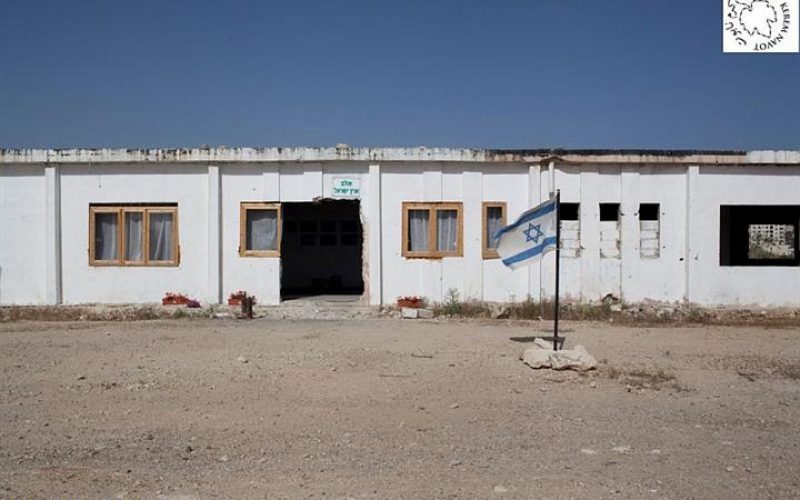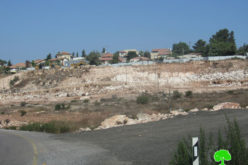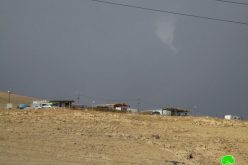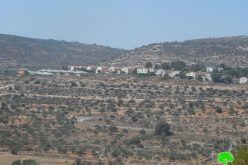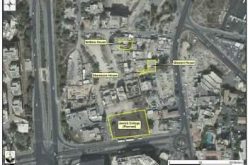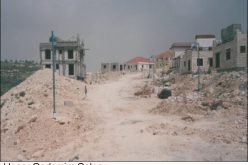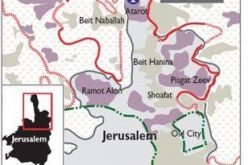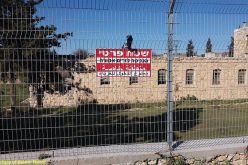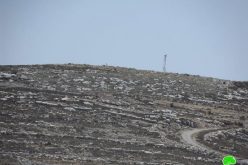A Jordanian Military Camp until 1967
Osh Gharab, meaning "the nest of the crow" in Arabic, (عش غراب) is an area located about 4 km east of the old center of Beit Sahur, a town in the vicinity of Bethlehem. During the Jordanian ruling period over the West Bank (1948-1967) a military base of ca. 20 dunams was built on a hill overlooking the historical road which connects Beit Sahur with the Sawahra area (585 m above sea level). See Map 1
An aerial photo of Beit Sahur and Osh Gharab in 1970
Israeli Seizures and the Establishment of the Military Base 'Shdema'
Following the Israeli occupation of the West Bank in 1967, the military base in OSh Gharab was taken over by the Israeli army, as all other Jordanian military and police compounds have. Between 1971-1983 the Israeli military issued several land seizure orders to the areas around the original base, all of which amounting to 375 dunams (an area almost 20 times larger than the original area of the Jordanian base). The orders were issued in order to expand the training areas around the base, now named 'Shdema', and to turn it into the main permanent military base in the Beit Sahur area. See Map 2
375 dunams were seized by the Israeli military between 1971-1983 in order to expand 'Shdema'
The dismantlement of "Shdema" -2006
With the completion of the redeployment of the once the 'barrier' around Jerusalem, the Israeli military had completed a comprehensive redeployment in the area of Bethlehem, which included the construction of a few new military outposts and bases around the city of Jerusalem and the desertion of a few others. 'Shdema' was therefore deserted by the IDF during 2006. See Map 3
The breaching of the new "Liberman" Bypass- 2008
In 2002, the Israeli authorities began to carve a bypass, over 10 km long, in order to connect the new Har Homa settlement, built on Jabel Abu Ghnem (جبل أبو غنم) part of the 1967 occupied areas which were annexed to Jerusalem, with the settlements Tequa'a and Nokdim. The project was completed in 2008 and the road became the major route of transportation for the few thousand settlers who reside southeast to Bethlehem as well as being widely used by Palestinians who live in the area. This road is often being addressed to as the 'Liberman Bypass', after Avigdor Liberman, the senior Israeli Politian, who lives in Nokdim settlement.
Once the bypass road was opened, the settlers started to show interest in the deserted site of 'Shdema', as it is just above the bypass route. Reoccupying 'Shdema' perfectly corresponds with the Israeli settlements' strategy to build civilian and military outposts along the main roads of the West Bank. One of the most vocal advocates for pushing for the re-occupation of 'Shdema' was a group known as "Women in Green", based mainly in the settlements south to Bethlehem. In their website they openly explain their interest in 'Shdema':
"Shdema, under Israeli control (Area C), is located at an extremely strategic point that connects between Jerusalem and eastern Gush Etzion, and provides security for those traveling on the eastern Gush Etzion road….. In April 2008 the Committee for a Jewish Shdema, sponsored by Women in Green, began to maintain a permanent presence there, by organizing Land of Israel cultural activities at the site".[1]
Signs along the "Liberman bypass" directing in Hebrew and English to "Jewish Shdema"
July 2009 – The deserted buildings in 'Shdema' covered by Israeli nationalistic graffiti slogans
The Palestinian Reaction to the Eviction of 'Shdema'
Once the military base was evicted in 2006, the Israeli authorities were obliged to cancel the seizure orders and give the land back to its legal owners. This, however, never happened. A few years later, Beit Sahur municipality initiated the planning of a hospital on the site of the deserted military base. Parallel to this initiative USAID funded the construction of a new recreational park on the northern slopes of the Osh Gharab hill on an area seized by the Israeli military in 1971 for the expansion of 'Shdema'. The ICA issued 5 demolition orders against the 5 different structures in the park, but they were never carried out. See Map 4
USAID recreational park after its completion in October 2008
The Return of the Military Presence to 'Shdema'-2010
In the beginning of 2010 the settlers' pressure was proven to be efficient and the Israeli army established a permanent watch tower in Shdema and the place was manned again after 4 years of absence.[2] The military explanation was that this decision was based on security reasons and not as a result of the settlers' pressure, but it seems that what Nadia Mattar of 'Women in Green' told to the Jerusalem Post, sums the real story slightly more accurately:
“We feel that it is a step forward in the right direction,” said Matar, who added that she wanted to thank the thousands of people who had worked on behalf of Shdema as well as the Knesset caucus.[3]
Jan 2010 – Settles' vandalism in USAID park
The Settlers Establish a "Culture Center" in 'Shdema' – 2013
During 2013, a few years after the Israeli military reestablished permanent presence in 'Shdema' the settlers began to renovate the old deserted structures on site in order to convert the place into a "cultural – spiritual center". The renovations were paid for by the settlers who had the full coordination of the Israeli army that was present in the place.[4] The renovations were carried out in two phases: April 2013 and May 2014. Once the renovations were completed various events organized by the settlers continued to take place in 'Shdema', mainly on Fridays.
April 2013 – Settlers started to renovate the main building in 'Shdema' in order to establish a "cultural center" on the site.
May 2014 – the second phase of settlers' renovations in 'Shdema' included all the deserted structures in 'Shdema'
The Reconstruction of "Shdema" as a New IDF Base – End of 2015
During 2014-2015 the military presence in 'Shdema' gradually increased and the settlers' presence decreased accordingly. At the end of 2015 the Israeli Military started to reconstruct 'Shdema' as a permanent military base which is being used as it was until 2006, serving as the main military stronghold east to Bethlehem and Beit Sahur.[5]
[1]see: http://womeningreen.org/shdema/
[2] Ma'an New Agency,"Israeli Army to Reoccupy Base near Bethlehem", 31.01.2010 see:
http://www.maannews.com/Content.aspx?id=258146
[3] T. Lazaroff, "IDF to return to strategic hilltop", The Jerusalem Post, 2.1.2010.see: http://www.jpost.com/Israel/IDF-to-return-to-strategic-hilltop
[4] C. Levinson, "IDF Allows Israeli Settlers to Renovate Abandoned Base in Gush Etzion", Haaretz, 6.5.2013. See: http://www.haaretz.com/israel-news/idf-allows-israeli-settlers-to-renovate-abandoned-base-in-gush-etzion.premium-1.519496
[5] G. Cohen, "IDF Redeploys to West Bank Positions and Checkpoints It Shuttered Years Ago", Haaretz, 19.1.2016. see: http://www.haaretz.com/israel-news/.premium-1.698027
Prepared by
Kerem Navot

